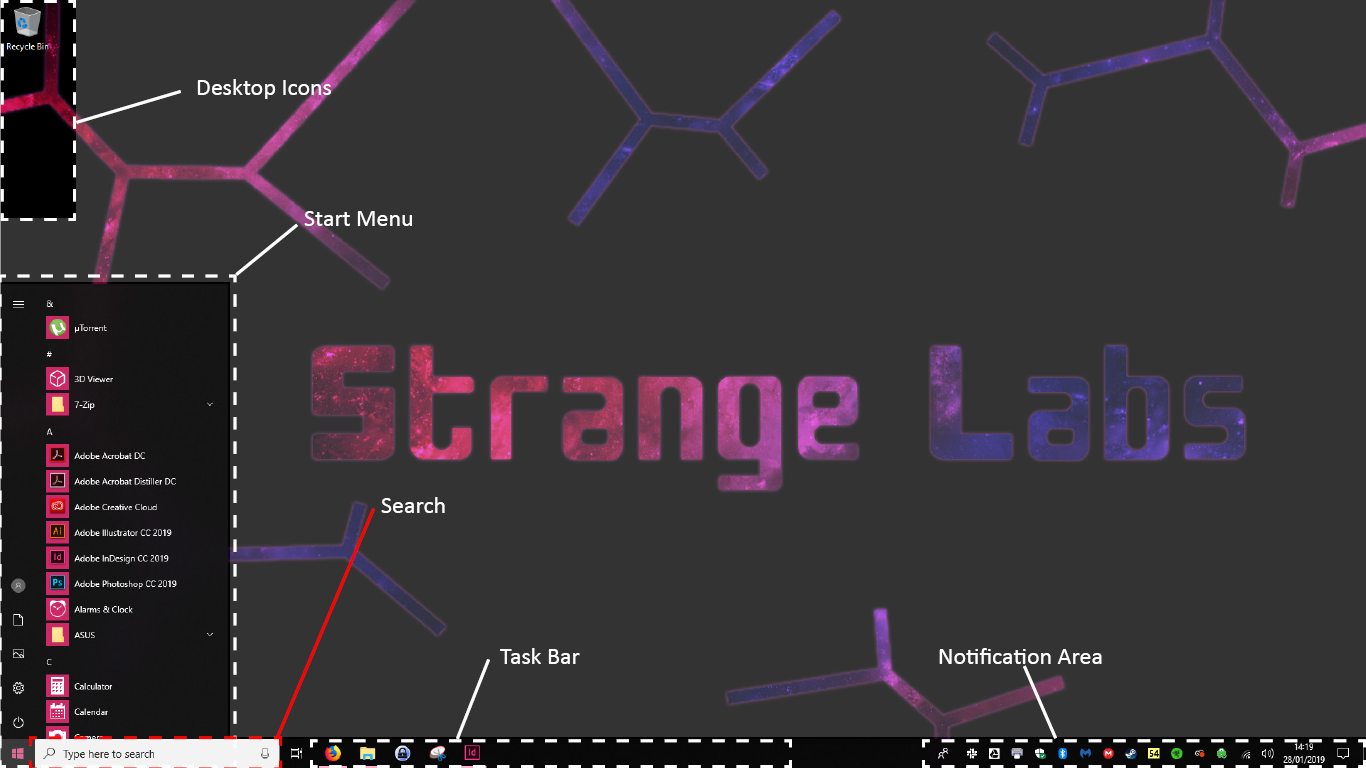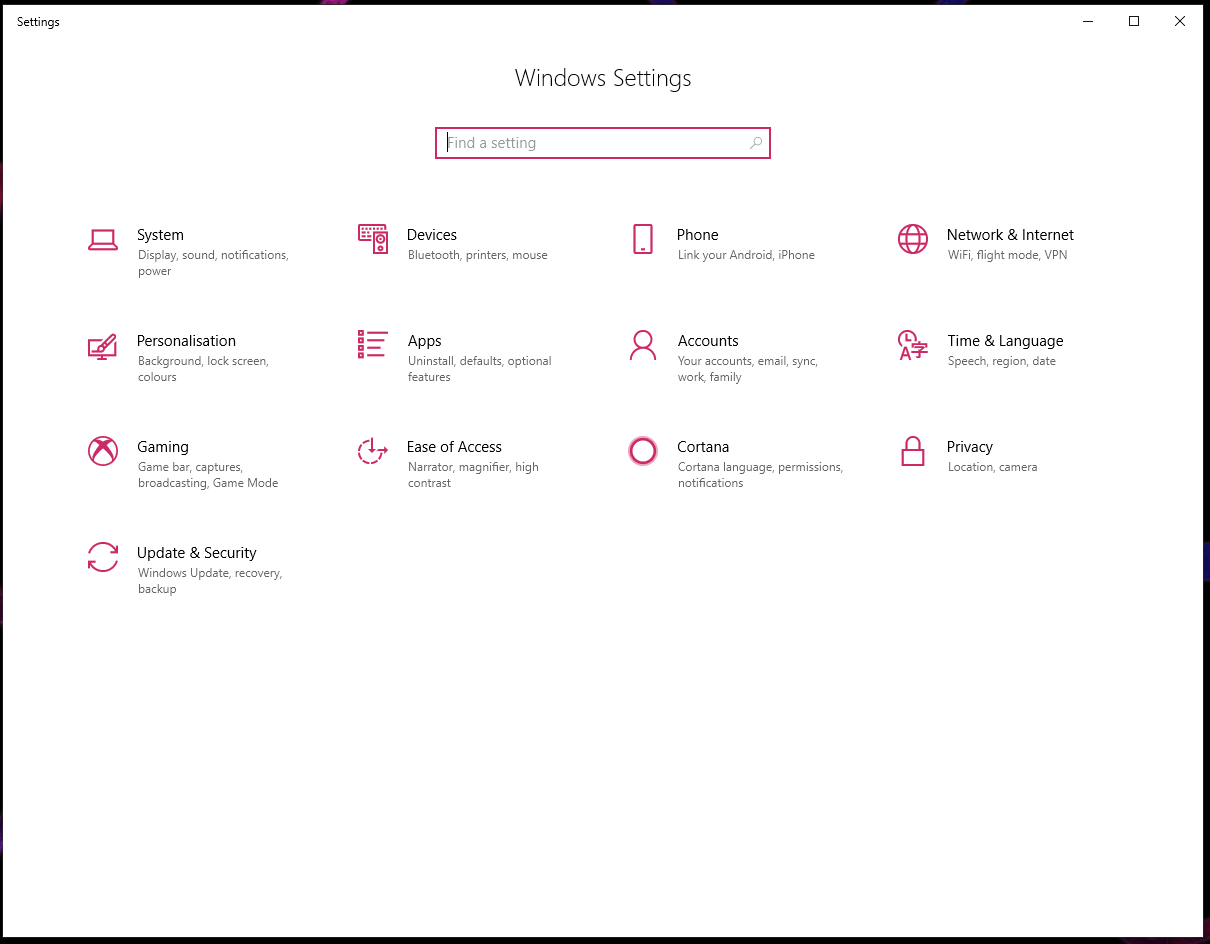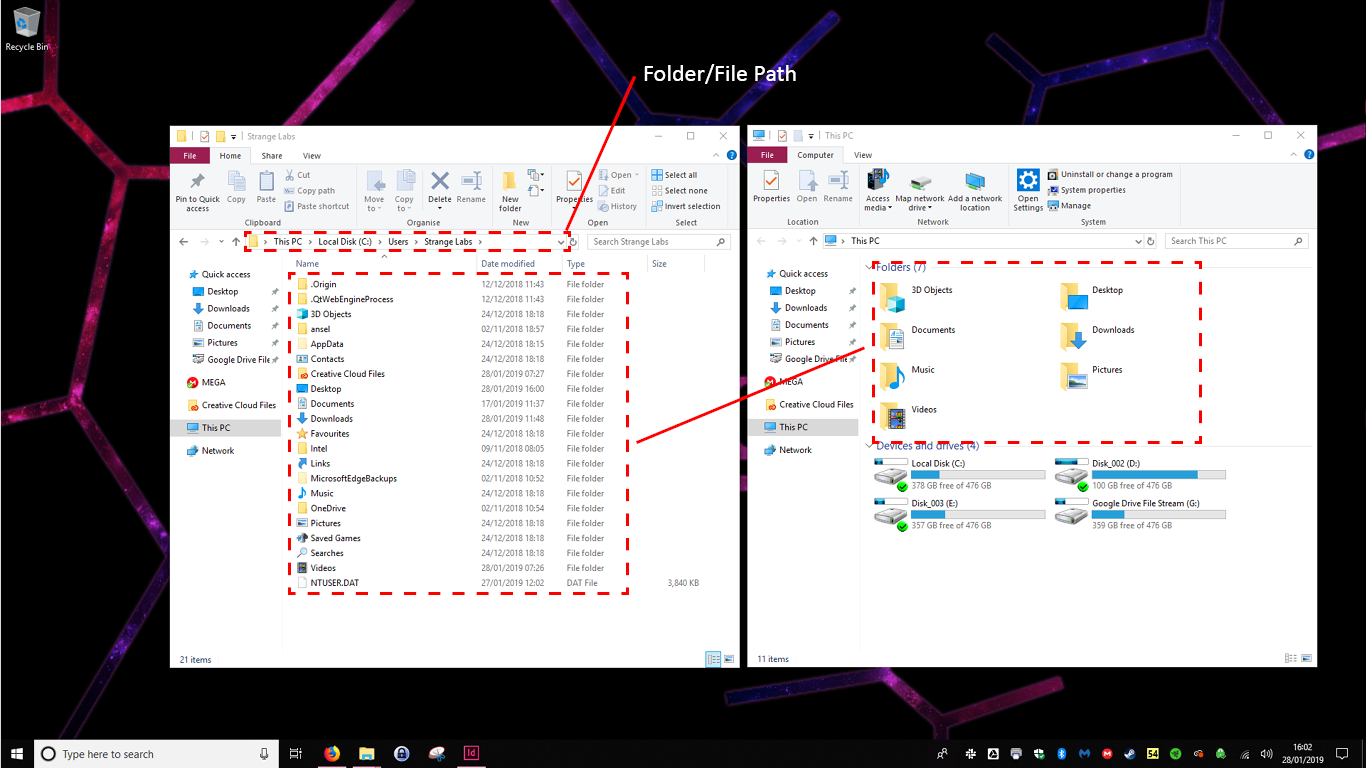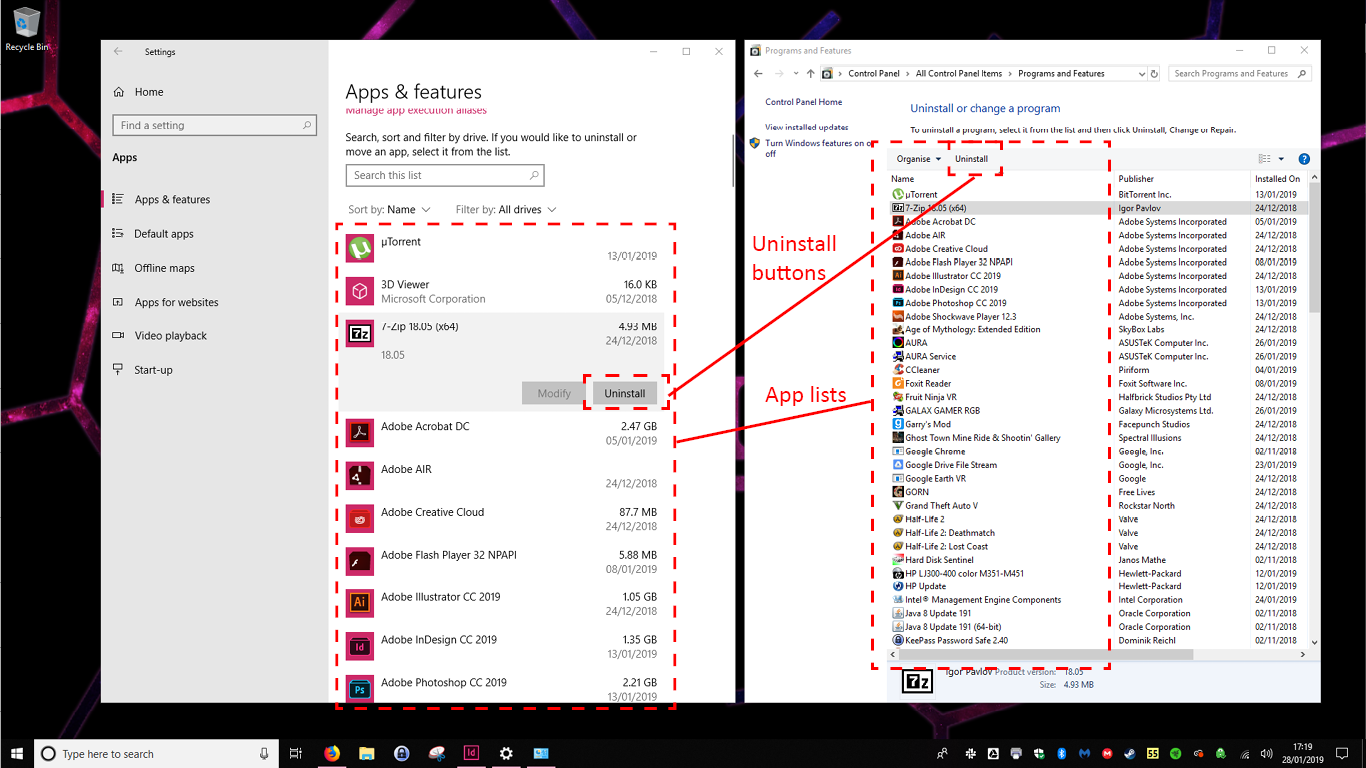Introduction
I have been asked many times for some help in getting started and achieving a basic understanding of the Windows 10 operating system (OS). Windows 10 came out on the 29th July 2015 but still people have some trouble finding their way around. This is, by definition, the result of substandard user experience and not necessarily Windows user’s own fault for not getting it. Of course a basic understanding of any computer system will help, but Windows 10 doesn’t make it as easy as it could be thanks to layers of abstraction built on what is essentially a combination of previous Windows versions underneath. So! Here is a guide to getting started and some general help and tips for our customers who have bought machines through us.
Screen layout.
Before we start using the computer, let’s familiarise ourselves with the Desktop and Windows Explorer[1].
 You are looking at the Desktop. The desktop has a background image, usually a few icons on it and a taskbar along the bottom. The Start Menu is the little Windows icon on the bottom left on the taskbar. This is how you find and launch your applications. Note - At Strange Labs, we by default remove all the tiles usually found on the start menu (found to the right of the application list but not visible on this image) as they are annoying. We also set the start menu to only show the application list and not offer suggestions or recent documents. You can change that in the settings.
You are looking at the Desktop. The desktop has a background image, usually a few icons on it and a taskbar along the bottom. The Start Menu is the little Windows icon on the bottom left on the taskbar. This is how you find and launch your applications. Note - At Strange Labs, we by default remove all the tiles usually found on the start menu (found to the right of the application list but not visible on this image) as they are annoying. We also set the start menu to only show the application list and not offer suggestions or recent documents. You can change that in the settings.
From left to right, the taskbar contains the Start Menu, Windows Search, Links (to apps or folders), Currently open applications (Adobe Indesign in this case - the little line underneath the icon shows you that app is currently running) and then finally to the right is the notification area. This also shows running apps, but apps which are running in the background. Sometimes, when you close an app, a little icon remains in the notification area. This means the app is still running but just not visibly.
Get used to looking at the apps running along the bottom. If your computer is not top spec and starting to be slow after time, just check to see what you have open down there and what you might be able to close.
Search
If you lose something, just search for it. It doesn’t matter what it is, application, picture or download, search will scour your computer for it! Sometimes you can move a file, or even find it is disappeared and cannto remember doing anything with it. Well before you panic, search for it. If it is deleted, search will not find it and then it is time to call us if it was important!
Settings
 So let’s start with settings. It is best practice to go through the system settings and customise them accordingly before anything else as this will often cover security and hardware settings unlikely to change in the future.
To access settings, left click the “start menu” (the windows logo in the bottom left) and click on the cog icon. Generally speaking cog icons or spanner icons refer to settings.
So let’s start with settings. It is best practice to go through the system settings and customise them accordingly before anything else as this will often cover security and hardware settings unlikely to change in the future.
To access settings, left click the “start menu” (the windows logo in the bottom left) and click on the cog icon. Generally speaking cog icons or spanner icons refer to settings.
There are a fair few things in here, and it is probably a good idea at some point to sit and go through each one to make sure it is as you would like your settings to be, but we will cover just a few.
Setting/ changing a password
You will find this in “Accounts” > “Sign in Options”. Note - you can set a PIN here too, set up Windows Hello (a way to log in through facial recognition) and connect your local[2] account to a Microsoft online account. Please beware however, you will still have a password underneath all of these additional options so DO NOT FORGET IT. Personally I do not set up anything besides the password.
Personalisation
If this is your computer, make it feel like it and improve your bond with it by personalising it to suit your taste. In the personalisation area you can change the colours, background image and edit the taskbar, start menu and general appearance of the operating system. All this is of course not neccessary for the functioning of your computer, but it does make it feel more personal which is actually a good thing if you want to get the most out of it and feel comfortable using it.
Windows Update
Windows is known for having probably the least robust updating system out of every OS on the market today. It repeatedly tries to updates in the background and then promptly ruins your computer when it gets shut off unexpectedly or you use it when Windows Update doesn’t want you to. A good way to help avoid this is to periodically go to Windows Update which is in “Update & Security” > “Windows Update” and click “Check for updates” to see if anything is pending. Sit and watch any updates update to get peace of mind that it is doing something and may not destroy your computer.
Other settings
As mentioned, it is worth going through all of these to make sure they’re all what you want. Setting your default apps (under “Apps”) is a useful one so you can pick 3rd party apps (usually better than Microsofts own) to open specific file types. And privacy of course to stop targetted advertising and the rest if you’re not into that!
File Management
Ok, now we have customised our computer, let’s get a grip on how files and folders work. Everything on your computer is a file. In fact, even applications are collections of files. Very simply put, the difference between a Word Document and a file to do with an application is that your Word doc is a readable and writeable file and the app file is an executable file. Anyway the only thing to note is everything is a file. Folders, on the other hand, are paths to files. The root[3] of your whole local Windows computer is (usually) called the C: drive. This is the partition on your hard drive (or SSD) which contains the Windows OS and all your stuff. If you were to create a folder on the desktop (you can create a folder by right clicking anywhere and selecting “new” > “folder”) this would create a folder with path C:/Users/Username/Desktop/New Folder. Folders are very useful ways to collect files together. It is very good practice to keep your files organised on your computer.

Home Folder
The files you need to be concerned about on your computer are the ones contained in your Home Folder. This folder contains (or should contain) your pictures, videos, documents, downloads and everything else which is not a program or fundamental part of the OS. The image below shows you both the home folder contents (on the left) and the same folders in the “Quick Access” part of the default window that opens when you click on File Explorer. These are the same folders.
These folders have opened in what are called windows, hence the name of the OS. Every rectangle you see on screen, whether it is a folder, or application, has opened in it’s own window.
Note the file path on the left window. You can see it says This PC > Local Disk (C:) > Users > Strange Labs. This is just a more user firendly way of writing C:/Users/Strange Labs.
So, these are the folders (In your home folder) that you should aim to put ALL your files. Every thing you download from the internet, pictures, email attachments, application installers, etc, will all by default go into your Downloads folder. It is wise to regularly go through this folder and move things into the other folders if you want to keep them. Ie. If you download a movie, move it to your Videos folder. Anything you don’t want. Just click “Del” to send it to the Recycle Bin.
Often, you will find if you use an app to organise and view files, Picasa for photos for example, that the app will create or use the folders in your home folder to store files. So if you need to copy photos to a USB stick but cannot do it from within the application - simply go to the file path in your home folder to find them.
Copying, Pasting and Moving
There are two ways to get a file from one place to another. The first is to copy and paste. This will happen by default when going from one drive[4] to another. You can copy and paste by highlighting what files you want to duplicate and then either dragging them from one window showing one drive, to another window showing another drive. Or you can right click[5] on the highlighted files and select “Copy” then in the window of the location you want to copy, right click again and select “Paste”.
If you drag files from one place to another on the same drive, they will be moved and not duplicated. The right click method to move is actually called “Cut” and “Paste”. Be aware of whether you are moving or copying files to help remember where things are!
Installing and uninstalling Applications
The final part of this introduction is about installing and uninstalling applications. The three main reasons to have a computer as I see it are: 1- to access the internet, 2- to store and view (read) data and 3- to create and manipulate (write) data. In order to create and edit new types of data you may well need to install new applications. We cannot open a .psd file with Microsoft Word, for example. We need Adobe Photoshop, or another application that can read that file type.
Similarly we don’t want redundant applications we never use clogging up valuable space on our drive. Or, even worse, running pointlessly in the background and needlessly slowing our computer down. When you buy a new computer from somewhere like Curries (not from us fortunately!), it will come pre-loaded with lots of largely uselss applications known in the industry as “Bloatware”. It is a good idea to remove what you don’t need and so we will cover uninstalling first.

Uninstalling
One of the abstractions of Windows 10 that leads to some confusion is that there is now two ways to uninstall your applications and often one way will just lead you to the other way. Very annoying, thanks Microsoft. See the image below:
If you click on the “Start Menu”, then the “Settings” cog and go to “Apps” you will see a list of “Apps & Features”. This is a list of what you have currently installed. To uninstall, simply click on the app title and then the “Uninstall” button. Sometimes this works. Sometimes it opens a new window, the one on the left.
This window is in something called the “Control Panel”. You can find it by clicking on Search on the taskbar and typing in “Control Panel”. If you then go to “Programs and features” you will find a very similar list of apps to the one found in settings. You may remember this Control Panel from earlier versions of Windows as it was the main settings location back then.
Installing
Installing can be a little bit more risky as it involves writing to rather than deleting from the drive. This is a very good way to get a virus if you are not careful with what you install. Most things you choose to install will be from the internet (CDs etc are being phased out slowly, and often the most up to date version of software will be online and not on disk). Usually, to get new software you will need to download what is called an “Installer”. This is an .exe file which runs and consequently writes files to various parts of your OS so that the application you ar einstalling runs correctly.
Make sure you are sure where you are downloading from! As a general rule, only download installers from the manufacturer of that softwares own website.
To run the installer, simply double click on the .exe file. This will open a window with instructions about how and where to install the application to. Generally speaking, stick to the default options that come pre-filled by the installer (such as installing to C:/Program Files)
When you go through the steps, before you click “Next”, “Continue” or “Install”, just double check there are no little extra checkboxes ticked that give permission for other software to install themselves, piggybacking off the main installer. Usually it is McAfee or some other horrible program that tries to aggressively give itself to you…
Once completed, your program is installed (sometimes you need to restart the computer to complete). You will now find that program in both the lists in Settings > Apps and the Control Panel > Programs and features. You can launch the app through the start menu or any icons placed on the desktop or taskbar.
Conclusion
This should be enough to get you started as a basic user and allow you to gain the confidence to use your computer effectively. When in doubt, don’t uninstall or delete files you don’t know about, but have the confidence to go through menus and try out new things! And remember BACK YOUR DATA UP! Check out the other blog post How To Think In A World Of Cyber Crime for more help with that and passwords.
Pro Tips
[1] Windows Explorer is an application which runs from the point of loading the OS which displays the Desktop folder on the desktop and gives you your visual aid to explore the computer through the display. Everything you see on screen is an application.
[2] Local refers to something which is only affecting your physical machine. A local account and password is an account and password stored on your physical, “local”, machine. A Microsoft online account is stored on Microsoft’s servers elsewhere in the world and therefore is not local.
[3] Root is the lowest level area.
[4] A drive is essentially a component which allows you to have access to data. A hard disk drive is a mechanical spinning disk which stores data, a CD Drive lets you put a CD in, a USB stick is a flash drive, an SSD is a sold state drive (basically a bigger more robust flash drive). Google Drive is a drive somewhere in Google’s datacenter which you can store data.
[5] The right click is the Menu click. If you want to know what options you have with something, try right clicking and it should bring up a menu of available commands.